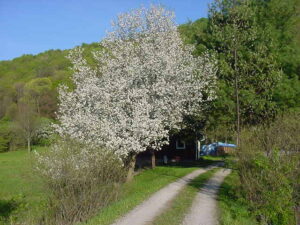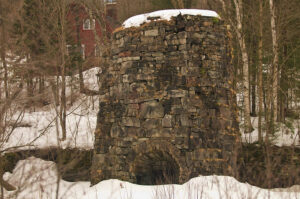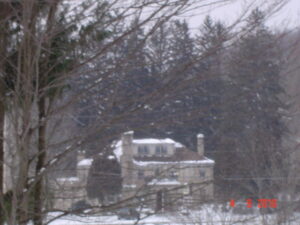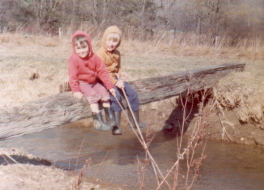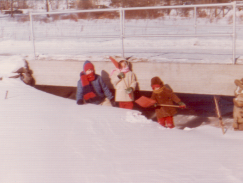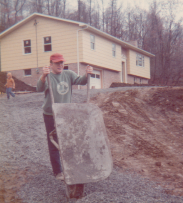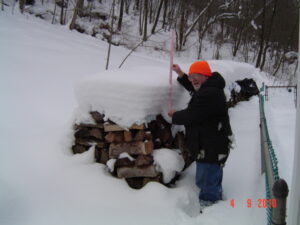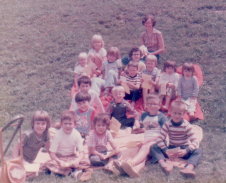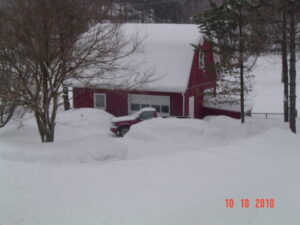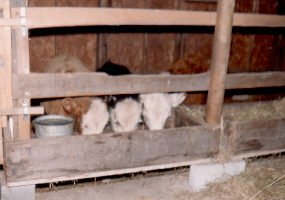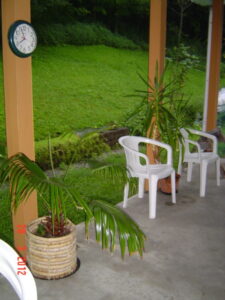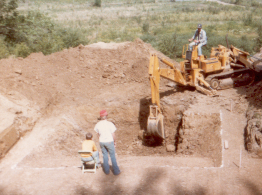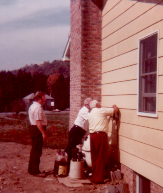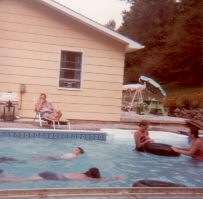Chapter 3D – Forward to Forwardstown
i. Planning & Making: (1972-1982)
Probably few people except the locals have ever heard of “Forwardstown.” I’ll tell you where the name came from in a minute, but Susan and I are proud to say that we have lived here since the day after Christmas 1975, going on 50 years now. That’s not much, considering the history of the area. Having been helping Susan’s Uncle Lawrence, co-owner of B & K Construction of Johnstown, with the building of our first real residence since Labor Day of that year, we were finally ready to move “down over the hill” from Jerome. This half-century section of Chapter 3 will be divided into five parts, roughly a decade each based mainly on factors like career moves and family situations. So, if you recall, by September of 1972, we were married with our first child, I was done with my first graduate degree, and the three of us had moved to Jerome, awaiting the arrival of our son. Our planning to build a home of our own had begun at about the same time. I must say that I was not exactly aware of how the relocation from Conemaugh Township, a suburb of the big city Johnstown, to Jenner Township, really rural, would affect us. This area, named for Dr. Edward Jenner, a British physician who invented the smallpox vaccine, would be a more country division of Somerset County with no police department and thus, lower taxes. Little did we know how important in history Jenner is, even today, in saving the world from Covid. The reason for deciding to build on this 9, eventually 18-acre piece of pasture land was that Susan’s brother Dan, after marrying LaRue a few years after Susan and I had married, was also looking for a place to settle and stumbled upon a 60+ acre farm whose owner, an older woman named Mrs. McSherry, was moving to New Mexico. She was a descendant of the area’s O’Connor family, about whom we’ll hear later. Local legend has it that her family introduced the Pennsylvania apple to that part of the country. Here, I thought it had been Johnny Appleseed.
The farm land we bought across the road from the McSherry residence wasn’t very well suited for anything on a major scale, planting or grazing, because of its steep hillside to the south and swampiness along the creek. After finding little demand for the house, barn, and land as a whole, the owner and realtor had decided to offer it in pieces. An employee of the State rehab center in Johnstown bought about a third. He had plans for constructing a small barn on the uppermost grassland atop the property and buying some horses. That never happened, as he divorced his wife and moved away. But before he did, he made me an offer I couldn’t refuse. I’ll explain later, along with who got the middle portion.
Let me tell you a little history of this hamlet. Our village of Forwardstown is named after Ross Forward, a 19th century young man from a family of politicians, lawyers, and investors. Aside from earlier legal records, the first public, printed proof of the town’s existence is the 1876 Beers School Atlas of Somerset County. Back then there were seven wood-framed houses along with a mule stable, blacksmith shop, and sawmill. Not on the map are a public school, small general store, and handsome stone iron kiln, one of the oldest in the county, known as Somerset Furnace. This was supported by pockets of ore and small, hardened pools in the sandy soil called “piglets,” where the liquid iron ran to cool before being floated on rafts in the creek or loaded onto wagons headed for bigger boats in Johnstown. The next stop were the mills of Pittsburgh, before Johnstown had built their own mills. The raw, red, powdery ore was melted in the Forwardstown furnace with burning charcoal, a by-product of hundreds of trees that were cut down, cut up, and cured (partially burned) before being layered with the ore in the kiln. These old kilns went out of business in the mid to late 1800s with the development of the Kelly Converter in nearby Johnstown. Today, I still find chunks of green glass on my property, just across the road from the furnace, and remnants of those cooling pools, results of sand having been melted in the heat along with the ore.
By the way, a township near Pittsburgh is named for the Forward family. Our Forward’s father had served in Congress from 1825-1831. His uncle was a Pittsburgh judge and U.S. Secretary of the Treasury under President Tyler. His farm comprised the affluent, modern-day Squirrel Hill in Pittsburgh. We hope to post he full story of our Ross Forward and his other famous relatives in the future. Perhaps the most interesting ending involves Ross’ competition with the Wright Brothers to invent a “flying machine.” He died before his ideas ever became a reality. He is buried in Cincinnati, where he moved after leaving Western Pennsylvania.
A self-employed carpenter and furniture builder from Johnstown, whom I’ll call Tom, moved into the McSherry house across the road from us with his mother and occupied the middle third of the old farm. He always boasted of his intention to fix it up, and he did improve a few of the rooms but left the outside a wreck because he claimed that this kept his taxes lower. The middle portion of the McSherry property had a large barn where he raised pigs and kept a horse for a time. As with the house, Tom never made any visible improvements and eventually the barn caved in. Now, all of the land in Forwardstown sits over an underground mine that, when it was working, used what was called the “room and pillar” method of extracting coal from some 800 feet below ground. The men would hollow out rooms with heavy machinery at the end of each inclined shaft and load it onto small cars. Then, after the designated area was “honeycombed,” the machines would go back in and push over the walls to the rooms holding up the ceiling. Of course the roof would collapse in a controlled fashion, proving additional coal for loading. Unfortunately, each time the pillars came down, the area above the mine experienced a small earthquake. I’m told that this practice was legal, but the land owners more often than not experienced damage to their homes and buildings. While I don’t know of any major cracks in the house, I do remember lying on the family room floor downstairs watching TV and feeling the whole house shake. The various State and Federal government departments overseeing mining took several surveys, but little was done to remediate the damages. Finally, the mine went out of business. Either the coal ran out or the market for it dried up. More about this in Section 3Dii. As I said, one day Tom’s barn collapsed. I called to tell him that he might want to be part of the government study and possible reimbursement. He replied, “Oh, don’t say anything to those people. I have a check from my insurance company coming.” As the old adage goes, “A bird in the hand is worth two in the bush.” Another thing we said about Tom and his buildings: “A cobbler’s children don’t have shoes.” Tom was so busy helping others that he didn’t take time to help himself. We’ll learn more about this gentle, generous man with a giant sense of humor and how he helped Susan and I over the years before his death in his early 70s.
So, all this leaves a final third across the roadway known as Somerset Pike. Brother-in-law Dan proposed that we split the acreage totaling about 18 acres. The property is just three miles north of where Susan grew up, even in the same school district she had attended. The purchase was complete in 1973. What made it even better was that Dan sold me his half some years later after he found “greener pastures.”
After going to the lawyer to have Dan and our halves of the property re-joined a year later, I set out to make plans for our new house. The land between the road and the stream, a tributary to what’s known as the Ben’s Creek, is considered wetland. This is a trout-rich tributary of the more famous Stonycreek, which furiously joined the Conemaugh River several times over the years to flood Johnstown. I had a fellow from the State conservation office in Somerset come down for an informal study and conversation. Walking all over the property, he gave me some tips on improving the old cistern that provided Tom’s house with water and would serve us as well for the first year of our occupancy. Finally, we stood on the hillside and he looked out over the land toward the road. He pointed to two, almost equal swampy areas with what looked like a dry path between. It came right toward us from what is known as the Roaring Run Road between Tom’s house and the historic yet controversial Casa Nova Bar and Restaurant, which we’ll hear plenty about in Section 3Diii. It was as if someone had already laid out the route for our driveway. All I’d have to do would be to build a bridge over the stream and haul “dirt,” as we call it here, to keep the cars up off the water table. Stay tuned! The year after we moved into our new house, and we found out that the water pressure from Tom’s small cistern was insufficient to provide a suitable flow to our main floor, we also learned that Dan had made arrangements to get water for the new house he was going to build. This was before he sold his land to me. That water would come from an enormous cistern above his side of the property that had provided water for the Casa Nova before they were required to tap into the public water supply that was run down Roaring Run many years earlier. I believe that, in constructing the 10,000 gallon reserve on the side of the hill, the workers must have created a path through the wetland, perhaps driving through the stream, and up the embankment. With this, my plan for a driveway and bridge was complete, if not inexpensive. But wait, I also had a plan with which I could save money. This was around 1974.
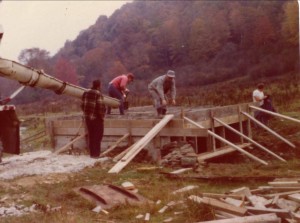
“RO” Miller (gray hat), me (red shirt), and my brother Carl (white shirt) on the
bridge project to Larry’s new house, Oct. 1974
My father-in-law, Dick or “RO” as he was known, was an experienced cement contractor who had built bridges. I had two neighbors, Tom and Mel, with excavators, dump trucks, and lots of earthen fill. I had a brother, Carl, who loved to get his hands dirty, and I, Larry, could do nothing toward providing a house for my family without this driveway and bridge. I had the desire and, if you’ll excuse the expression, “drive” to “get ‘er done,” as “The Cable Guy” would say.
My father-in law had three old large steel beams, several smaller ones, a number of reinforced concrete slabs, and lots of forming planks left over from jobs he’d done over the years. He hauled them down on his old pick-up truck and stacked them just off the flood plane. He explained that he couldn’t start the job until the fall because of other commitments. That was perfect because it gave me time to have Mel haul the fill for what I’ll call the “front” side of the driveway, about 300 feet at a depth of three feet. A professional excavator, he had been selling, digging, and hauling heavy clay mixed with rocks from the hill behind his house just two miles away for years. At first I told him that I could “smooth out” the dirt by hand so the cement truck could get in to the project. It didn’t take long to realize that this was more than one man could do with a hand shovel. Mel gladly swooped in with his bulldozer to finish the front. Next, Tom carefully dug for the footer for the bridge with instructions from RO. It was obvious that both had done such a thing before and knew exactly what they were doing. Fortunately, it was October and the creek was low. In the coming weeks, after work and on Saturdays, Dick and I hammered together the forms for the foundation walls on either side of the creek. When that was done, and RO had figured out how much concrete we would need, I called the hauler out of Johnstown for a day when my brother could take time off from his long haul trucking to help. Everything and everybody came together. The weather was perfect, and the job got done. You can’t imagine the sense of relief I felt when the foundations had been set and the creek could once again flow freely on its own route between the walls. I hadn’t gotten any kind of permit or permission to build a bridge and possibly interfere with a natural waterway. I know I could have gotten in trouble, but I would have pled ignorance and faced the consequences. If anyone minded my “mistake,” they never said, and now what’s done is done. I don’t think I’d get away with this today.
After RO was certain that the walls had dried, we removed the wooden forms and back-filled the footers by hand. Next, the three large steel beams were put in place over the water. They would be painted later. The multitude of smaller beams were laid perpendicular on top of the larger beams, just far enough apart to accommodate the reinforced cement slabs. Finally, a number of long wooden planks were placed on edge across the creek, resting on the ends of the walls for decking forms. Likewise, planks were placed at the ends of the large steel beams that ran across the creek and others perpendicular just atop where the side rails would be. This would provide sloped curves on the edges, where water from the deck could run off. Again, RO figured the amount of cement needed, and I called the cement truck. This “pour” seemed to come easier, probably because I knew what to expect. Using both a long-handled “float” and a hand trowel, RO finished the job. In a few days, when he was confident it was dry, we removed the forms, to my delight. Recently, I wrote a short Meditation on what that bridge means to me.
Two special additions: While the curbs were still wet, we had the kids, 4-year old Annie and 2-year old Matthew, put their tiny hand prints on top, alongside their initials and the date. After the curbs were completely dry, my dad, Ralph, installed aluminum hand rails on the curbs, more of a psychological barrier to cars going into the creek below than physical prevention. These special additions remain today, nearly a half-century later. But the job was not yet complete. Mel came by with loads of fill for the “back” side of the bridge and driveway to the bank below the future site of the house and barn. I placed a drainage pipe under the drive near that back embankment. Mel graded the driveway to my satisfaction. To save money I told him keep the height of that part at two feet, which he did. I regretted that request in the next few years as the snow easily drifted it shut. Those were the days before I had an ATV with plow to keep it open. During the winter of 1978, when I was in Haiti on a mission trip, Susan and the kids had to stay with her parents because she couldn’t get in and out of the driveway. It wasn’t long until I was on the phone with Mel asking for more fill.
As the house was being built in the fall of 1975, I was doing the handwork for water and sewage. Digging the ditch for a black plastic pipe from Tom’s spring to where the laundry room would be in the back basement was easy, a job I did a few evenings after work at my white collar job. My plumber had the unusual last name for a man who worked with water, Mr. Cable, but he drilled the hole in the wall and hooked up all the hot and cold water. Before I could have him install our sinks, tubs, showers, and toilets, I had to have a sewage permit. I called the Township office and paid the $50 for the inspector to come out. At his instructions, I dug a five-foot hole where the septic tank was to be, and six two-foot holes around that pit. Understand that on a property that “perks,” any ground water will quickly settle into the soil, thus eliminating the liquid part of waste from washing and toileting. Well, by the time the inspector got to the site, not only hadn’t the holes perked, but they were filled to the brim and overflowing. What was I to do? We didn’t have public sewage anywhere near, and still don’t. Also puzzled, the inspector asked me how much acreage I had, and I said, “Eighteen.” Relieved, he smiled and informed me that I didn’t need a sewage permit for anything over 10 acres. Even more greatly relieved I held out my hand and asked him for my application fee back, to which he laughed and said, “That paid for me to come out.” In the end, so to speak, I had Tom use his backhoe to dig the downhill sewer line from the house to the septic tank pit and the back-and-forth line that dispersed the fluids beyond where the barn would eventually be. Every few years I dig down to open the top of the tank to allow a professional “sewer sucker” to do his job and keep my system working.
As I said earlier, the year after we moved into our new house we discovered that the water pressure from Tom’s small cistern to our main floor was insufficient. I got the idea to hook up to the large Casa Nova cistern. It was about 600 linear feet from Tom’s spring and 50 vertical feet above the house. Not only would we have lots of water, but the pressure would be so great that my dad would have to install what are called “pressure relief buffers” in the laundry room to moderate the flow. Digging the line through the rocky, root infested soil was back breaking work. I remember the day my dad came to help install the black plastic line and, looking at my ditch, asked, “When are you going to finish digging?” He was serious. The depth of the ditch was only a foot in some places. He said, “That water line will easily freeze in the winter.” I knew he was right, but I explained how difficult it had been to dig with all the obstacles. Using a backhoe on that steep terrain was out of the question. We went ahead to unroll the heavy PVC and make the connections between Tom’s spring and the Casa Nova cistern before backfilling. Now we had lots of quality drinking water under sufficient pressure. It wasn’t long, however, before we decided that we didn’t need Tom’s spring as an intermediary between the big spring and the house. We decided to dig a shortcut up the grade, between where the line passed the house and Tom’s spring. I still smile today when I look at the junction box Dad built to protect the valves up there. He used 4 X 6 foot pressurized beams, covered with waterproof sheeting and filled the large hole with styrofoam pieces. A plastic five gallon can filled with foam pieces, as I have at other junctions, would have done the job. The junction box was so carefully constructed that I’ve thought of being buried up there when the end comes. Just kidding!
As you’ll read in the last installment of this chapter, about the same time as my hip replacement in 2018, the roofs and portions of the walls on both cisterns collapsed, mostly due to age and natural forces. Not being able to climb the steep hill, I was unaware of this tragedy. Fortunately, I was able to wire up the failures and, after having the water tested, we had just enough potable water for us two adults. Even better, I formed a plan to rebuild the necessary structures for the next owner. Keep reading!
I said earlier that I thought my brother-in-law had an agreement to use the Casa Nova’s cistern if and when he built his house on the acreage next to mine. Well, after Walt, the old owner-bartender of the bar died, I got a letter from the lawyer who was settling the estate informing me first, that the spring was on property owned by someone other than that owned by the bar, and second, I would either have to buy the tiny plot on which the cistern sits or unhook my water line. Furthermore, there was a second, smaller cistern further up the hill, that supplied additional water to the lower one. I didn’t even know that it existed, but I would be buying that one too. The bill came to several thousand dollars, which I didn’t have, but the principle was that I thought my relative had permission to use the water. The estate’s lawyer was my lawyer, a friend and neighbor of my wife and her brother as they were growing up. I stopped into his office in Somerset one day to ask a question about the wills he was preparing for Susan and me. I also informed him that we intended to buy the spring properties, but that, giving him a wink, perhaps he could stall this aspect of the estate settlement. Well, as such legal matters go, it was probably a year until I got a second letter asking for my decision. By that time I had the money and we realized that there was no way we could do without this water. I’m reminded of this tale twice a year when I get a bill for property taxes on two 10 X 10 foot plots. I wonder if they’d tax my beneficiaries if I were buried up there?
I had arranged financing for our new house in late spring of 1975, but we had to wait until August to break ground because of Uncle Lawrence’s previous commitments. I remember stopping at his office to approve of the plans, and he told me that I could save money by doing some of the work myself. I was a “white collar guy by then and had never built anything. As a drove home, I thought, “Ye know, maybe I can actually learn something AND save money.” No sooner did I walk in the door at Jerome than I picked up the phone, called B & K Builders, and told Uncle Lawrence that I would do as much of the work as I could myself. The split entry design was perfect for the side of the hill where it would go. The single-car garage on the left would stick out of the ground, accommodating a side door. Five front steps would allow access to the front door, half-way up to the main floor. A back door would be reached by a full cement staircase around to what would be a large porch. So, after the foundation was dug and the footer poured, the cement block walls were laid around the basement. Susan and I had driven south to Springs, PA, to select the brick that would show on any exterior basement walls that stuck out of the ground. Ironically, the brick yard was just a mile from the home of her Amish Ancestors. This was all done by Labor Day, and Susan and I were committed to parge them, that is coat them with waterproof black tar. We worked fast so as to be able to attend a Monday picnic at my brother’s house in Mars.
We returned home to find that the contractors, mostly Susan’s cousins, sons of Lawrence had not completed enough of the wood-framed main floor and roof to protect the plywood sub-floor and rain had cause some of it to separate. This was not a problem as Lawrence simply covered the damaged area with thicker, more synthetic sheets. One major misunderstanding involved the walls of the main floor. I had been under the impression that they would be brick-cased while the contract called for wood-frame with synthetic siding. We had just a short time to make-up our minds about which we wanted. Adding bricks would mean fastening them to holders nailed to the wood framing. The extra, no-maintenance materials would cost less than $2,000, which seemed a lot at that time. We opted for the synthetic 12-inch siding, which would require painting every 20 years. It’s time to re-paint now for the second time. I ache to think about it!
The next step, after the exterior walls were complete, the doors were hung, and the roof was installed was pouring the cement floors in the basement and garage. I remember watching the cement truck pull in the rough driveway, filling the wheelbarrows pushed and dumped by cousins Wayne and Tom to the four basement rooms. Swinging the shoot to the corners of the garage was all that was necessary through the large door opening. Seemed like all that was the easy part. The floating and hand-troweling was the hard part. I actually helped with that when I built the exterior garage slab, barn, back porch, and pool deck years later. The cousins were on the job until long after dark because the cement took its good old time to dry, underground and out of the sun in hot and humid early autumn. The exterior cement steps, sidewalks, and porches were formed and poured with help from family, friends, and neighbors.
One of the applications that made our new abode look like a real house – not “home” because we’re not quite there yet – was the fresh plaster on walls and ceilings. A family of second generation slavs (or serbs?) did the whole main floor in less than a week. At the same time, builder Lawrence had a hole cut in the floor toward the center of the house through which a vent entered from a portable furnace in the basement. By this time of the year the outside temps were probably in the 40s, too cold to dry the plaster. Within a few days before Thanksgiving everything was ready for the finishing touches. Brother Butch joined Dad, Richard, and me in getting the final pieces of sub-floor in place, the interior doors hung, and trim attached accordingly. I believe the girls were back in Jerome beginning to pack for the anticipated move just after Christmas. Oh, and they prepared a wonderful Thanksgiving feast.
Most of what I did between the holidays was outside, hauling gravel to cover the sewer seepage bed downhill from the septic tank which was downhill from the house, naturally. I remember the date as December 2 and the air was filled with breezy snow flurries. I had fashioned what reminded me of a two-sided Asian “carry-around-the-neck” yoke. I felt like a cross between an ox and a Chinese coolie: a wire hung on a three-foot 2 X 4 across my shoulders supporting two plastic five-gallon buckets filled with gravel. It worked pretty well, but by lunch time I was ready to go inside where it was warm and consume some hot soup.
All of the gravel was what we gravel experts call “2B,” large enough to drive over without crushing but small enough to allow bicycles to pass. The base of the driveway was shale and crushed fieldstone so the gravel didn’t sink into the mud. How many trips I’ve made from the gravel pile with the wheelbarrow down the tire tracks. Don’t forget, our drive is almost 900 feet from the road to the house. In the early days I could get a driver from the stone yard to place short pieces of 1 X 12-inch boards under the tailgate, allowing the stone to only come out on the tracks. The younger drivers now apparently never heard of such a thing, so I have to either rake the errant gravel from the median to the tracks or, as I said, simply shovel it from a wheelbarrow or small ATV cart hauled from a pile, usually dumped in what I call the “turn-around.” Anyone in charge of driveway maintenance will know what I’m talking about.
I also had some rough landscaping done in late Fall, over which I had some topsoil placed, laden with grass and weeds I might add. A “city slicker” would probably have some expensive loam dragged on the clay base, to which he would add the finest seeds, chosen exactly for the slope and sunniness. As the house was built on the side of a moderately steep hill, I figured it would be better to get those roots anchored, whatever kind they might be, before the winter rain and snow washed whatever good soil I had away. The plan worked and by summer my yard was ready to mow – by push mower, as I’ll explain later.
Absolutely at the end of our cash supply, Susan and I were prepared to walk across the floor on a few throw rugs our parents had contributed. To this day I don’t know if Uncle Lawrence was offering us an early Christmas gift or he had actually over-estimated the final cost of the construction. But, about the time he had received the final bank payment, he arrived with his own check for nearly $1,000, saying that the money was what was leftover in the account. That was a lot of money in the mid-70s, nearly two months net pay for me. Once Susan and I picked ourselves up off the rough wooden floor, we thanked him and took a neighbor up on an offer to carpet the entire living and dining rooms and the steps to the family room. This was-top-of-the-line fabric and after countless cleanings we still have it looking great today. The rest of the house was furnished with pieces of rugged, green all-season carpet salvaged by my Dad from his work, one of the advantages of being a building superintendent. He even installed it for us. Most of that carpet has long since been replaced, as money allowed.
So, by Christmas, we were ready to move in – except that the kitchen cabinets hadn’t been installed. What do I know about such things? It was Dad to the rescue. He could do about anything, and while we were loading our packed belongings into our cars and a pick-up truck driven by good friend Joe up in Jerome, He was carefully screwing the beautiful wooden cabinets to the kitchen wall. They were ready for Susan’s goodies by the time we arrived that afternoon, the day after Christmas, 1975. Was it the end of a once-in-a-lifetime experience or just the beginning of a new life for a young Somerset County family? A little of both, I’d say.
It had been a snowy day, and moving what used furniture we were able to amass wasn’t easy. Over the autumn months Susan and I took advantage of several local auctions to get what we needed: a four-poster bed, two dressers, a 50s-style metal dining room table, and chairs, of course. Since 1975, we’ve moved the metal table to the laundry room and moved in a gorgeous wooden dining room suite from my late parents’ estate. They willed us family room recliners as well. Several student desks made by Susan’s dad grace various parts of the house. My office elegant teakwood furniture was a gift from a friend of daughter Annie. We’ve certainly been blessed over the years. As you’ll learn in Chapter 6, we’re already thinking about what will happen to these blessings when the end comes.
In the early days, one of Susan’s family’s traditions was to invite folks over on a holiday for a picnic, and then put them to work. Once, when I questioned this practice to her dad, he replied, “Well, isn’t that what holidays are for. While I’m sure this never applied to the high holy days like Christmas and Easter, I do know that in Somerset County, Thanksgiving morning was given to butchering meat, if you can imagine. Anyway, for July 4th, 1976, they summer after we moved in to our new place, I had enlisted the help of my Dad and father-in-law Dick to pour the front porch slab, steps leading to it, and small landing at the bottom. Dick had already laid the short block and brick foundation on the footer I had dug and poured. We cut the forms for the steps and slabs, and I mixed the cement by hand. All went well until we ran out of cement. I had figured incorrectly and we were in trouble. What could I do. i got on the phone and called an old church buddy, Wilford, who managed Boswell Lumber, the area’s main building supply store. Second problem: the store was closed for the holiday. With all the nerve of Atlas, I related my dilemma. Wilford answered, “No problem. Come on up.” He and his family lived just across the street from the store and he apparently was anxious for company. Dick had patronized the store for years, and it was a good chance to introduce my dad to one of the patriarchs of our church. The moral of the story is, “Plan more carefully, especially on our nations’s birthday.” My lesson still is, “Don’t take advantage of good-natured people, but be thankful that they exist.” I’m sure I repaid Wilford many times over the years.
Our first days downstairs in the family room were spent lounging on a daybed, futon, or old over-stuffed chair that had been handed down through family. The ceiling still showed the fiberglass insulation stapled to the joists. The walls were cold cement blocks, and the floor was covered with pieces of green all-season carpet from a storage trailer that Dad had on his Calgon work site. All that changed when Susan’s dad, a cement contractor and mason laid the beautiful leftover brick from the exterior of the house against the fireplace wall. Knowing just what we needed, he constructed brick wood storage boxes covered with carpet-on-hinged-particle board on either side. In the middle was a tile-covered seat for sitting, complete with the Christian cross. This enormous project had been finished by the spring of 1977 when we held a dedication get-together for members of our Jennerstown United Methodist. Rev. Scrutin conducted the meaningful ceremony in front of a warm fire.
In the weeks and months that followed, I nailed 1 X 3-inch furring strips into the cement block walls on either side of the fireplace, between which I placed styrofoam insulation and covered everything with the most elegant walnut paneling I could find. The plasterboard back wall was originally painted an exotic orange by Susan, but afterwards she had it wallpapered. The simple tile ceiling was the last to be hung. Our young family spent most of our evenings watching TV there, after I had strapped a basic rotary antenna to the outside chimney. We were able to receive most of the Johnstown, Altoona, and Pittsburgh stations, although back in those days some were rather fuzzy. That antenna still stands proudly today, minus the VHF strip, but with the addition of a second UHF antenna for capturing the new “converted” signals. One strip points north toward Johnstown and the other southwest toward two transmitter towers on Laurel Mountain. Though we now get a dozen stations, we usually only watch the live, local newscasts. We’ve gone through several TV sets, and the newest, a small flat screen sits upstairs in the living room next to the baby grand piano. I had to move the antenna cable through a hold in the window frame there. Most of our time in front of the TV is spent watching ROKU, a cheap miracle of modern technology allowing us to see local newscasts from around the country. Although we don’t watch many movies, we enjoy keeping up with the news from our kids’ markets: Roanoke and Charlotte. A week wouldn’t be complete without “Music and the Spoken Word” from BYU-TV, Salt Lake, and some episode on Public TV from WPSU, State College. Although we had cable TV when it first came out Somerset Pike from Johnstown, our home today is entirely digital on the same line, with wireless telephone, computers, and TV, all for what we would be paying for just cable TV.
Both Susan and my parents’ first homes had been heated by coal, and while it was warm and economical, firing the furnace could be a lot of hard, dirty work. Susan’s home moved to oil heat after the energy crisis of the 70s, and my parents’ new homes were always natural gas, both clean and efficient. Gas wasn’t available in Forwardstown, and I didn’t like the smell of oil heat, having experienced it back in Jerome. Builders in the 70s were emphasizing the cleanliness and convenience of all-electric homes, so we decided to go that route. After the first winter, however, we were shocked at the price of running a stove, a water heater, baseboards, and meeting all the other demands for four people – hundreds of dollars a month. Many of the neighbors were installing wood burning stoves. What could be more sensible for folks living in the middle of the Laurel Highlands? We chose what is called a “Mama Bear” for the kitchen. Our new neighbor Dave helped install it just inside the back door with the flu going straight up eight feet through the ceiling and roof. Now, concern over power failures was a thing of the past; we could heat water and cook on the two levels. With nine acres of forest above the house, roadways needing to be cleaned of fallen trees, and lots of neighbors wanting dead trees taken from their yards, I’ve never had a shortage of logs. Did I mention the exercise I get from cutting, splitting, hauling, and stacking wood? While we don’t burn the family room fireplace much now, our Mama Bear burns constantly from November through February. Ironically, my summertime electric bill is more than the wintertime, considering the operation of the pool pump.
The covered back porch has always been the depository for the winter supply of carbon fuel. Other areas near the house and barn consistently contain at least three years worth of wood. Those piles are allowed to dry under old vinyl winter pool covers that otherwise would go to the landfill. My concern now is that I won’t live long enough to process the 25 or so giant diseased ash trees on the property that the State says have to remain on my acreage.
In the days before pre-school, our kids began school at age five with kindergarden, a half-day then where our neighbors carpooled. Beginning with first grade the school bus was caught at the end of the driveway come rain or shine. We weren’t the kind of parents who drove them out there in a car when a storm threatened. I still remember Matthew, slow to waken when he was in high school, running out the driveway to catch the bus, right out of the shower with shoes untied and shirt unbuttoned. The driver, always a kindly neighbor, waited patiently, with a belly laugh I’m sure. I’m also certain this was great entertainment for those looking out the bus windows. Our kids’ parents never bought them cars to drive to school, but we usually took them to their jobs in high school. By the way, the earliest “kinderkid” carpool was made up of the same group of youngsters who graced us that summer by participating in a Child Evangelism Good News Camp held in our back yard. This was a time of Bible stories, singing, a lesson, and snacks. Many of these kids still live around here and now have grandchildren of their own.
This brings us to the first of several monumental events, details of which I’ll give in the appropriate chapters. There was the murderous Johnstown Flood of 1977, dropping a foot of rain and killing 78 people. Our home was not affected even though most of the damage occurred only 10 or 15 miles to the north. Fortunately for me, the disaster mostly caused an upheaval, if not a learning experience, to my job and career. As we’ll learn, I was given a demotion at work, after which I earned more money, spent less time on the job, and had a lot more fun.
In Chapter 5 you’ll read about my mission trip to Haiti in 1978 with church friend Joe, mentioned above. I believe this experience caused me to truly appreciate my faith, my community, and my country. I realized that I have never had anything to complaint about compared to those dear people in that developing country. Furthermore, I took the opportunity to share that experience and photos and revelation with several groups around the area.
After my demotion, and I use that term advisedly, I had more time and resources to plan, study, and carryout several home improvements: a small barn in 1981 and a large back porch/patio and in-ground swimming pool in 1982. I had mentioned earlier that our land contained electric fencing in which a neighbor had several cows waiting to “freshen.” For those of you who aren’t farmers, that means that cows have to deliver calves before the produce milk. In grazing our property, these cows didn’t get mixed in with the milking herd up the road. Farmer Bob could anticipate the deliveries and knew where to look for the newborns and remove them from the mothers before attachment. Unfortunately, in the later Fall, after much of the grass had been eaten and a storm would render the electric fence ineffective, the pregnant mothers would get out. In one incident before we built our house, one angry neighbor with a cow in his yard angrily tried to “herd” the animal with his pick-up truck. The result was that he ran the cow into another neighbor’s vehicle, denting the side. That case was argued with the insurance company for years. Fortunately, after an interview statement, I was dismissed from the complaint.
In another “cow gets loose” tragedy that happened before we bought the land, another elderly neighbor attempted to corral a bovine and later suffered a deadly heart attack. I don’t know, nor do I want to know, all the details of that incident, but they were always in the back of my mind when I had animals of my own within a few years. This leads to the construction of the first full-sized building I ever attempted, a 16 X 30-foot barn.
The lot I chose for this masterpiece had to be close to the driveway, fairly level, and void of standing water. There was a piece that fit those criteria just below the turn-around where the kids played with the young neighbors amid the bushes. With rough drawn plans, I began by carefully measuring what was to be the outside, driving stakes at the corners, and hand-digging down below the frostline, about 24-inches. Then I hand mixed cement and poured it into the ditch, which had leveling “dams” to allow for the foundation blocks to rest evenly where the land wasn’t quite level. When that was dry, I laid standard cement blocks up to a height anywhere from two feet at the upper corner to four feet at the opposite lower corner, with allowances for a garage door in front, a standard walk-in door on the side, and a four-foot stable door in the back. Those blocks, by the way, had been salvaged from a pile along the road across from our driveway, put their by neighbor Tom. I had just about the right amount.
Where the block foundation wall came to an end, I cemented in long all-thread, which would be run up through the wooden base, held down with washers and bolts. This had held the barn in place over the past 40-plus years through high winds and other forces. So where did the 12-inch wooden superstructure come from? Again, I salvaged it from the neighbor who had planned to live on the hill above Tom. These pieces of antique barn beams, one 30-feet long, were to be the skeleton for his barn. Unfortunately for him, and fortunately for me, he got sick, sold his land, and ran off with the wife of the man I car-pooled with. While I had no pick-up truck at the time, my good friend Joe from our church did, and we maneuvered those odd-shaped, gigantic pieces down over the hill and into place, after they were cut.
The rest of the barn was eight-foot 2 X 4s and particle board, even up to the roof, although I pre-fabricated the roof joists on the upper floor, and with the help of my Dick and my mother-in-law, we nailed them in place. We quickly covered the joists with more particle board and fastened tar paper until the shingles could be applied. Another church friend, George, came along at just the right time to help with that job. If I recall, I had resigned my position at WJAC by then, and our young family took a vacation down the Blue Ridge Parkway and into Tennessee before finishing the roof. More about the job change in the next chapter.
All that was left on the barn project was pouring the cement floor. I remember asking Dad to come out from Pittsburgh to help. When he got here one mid-morning, he looked around and asked, “Where’s the help?” I replied with a smile, “You’re looking at it.” In disbelief he set about to inspect the site. I had backfilled roughly three-quarters of the barn floor up to about 4 inches below where the garage door would fall. I had placed a drain in the middle and gravel atop the fill. On the side where the corral would be, I laid up cement block and staked a wooden form to the top to where the floor would come. A single four-inch metal post reached from the middle of that wall to support the long center beam. If I recall, the entire pour took about a hour, as the truck chute reached the entire way to the back of the barn. But we had to work fast because it way a hot day in September and the cement dried fast. There was no time for fancy finishing, which was just as well because the floor would accommodate farm implements, a pick-up truck, and even some hooved animals from time to time. With the left-over cement we poured a simple sidewalk from the side door to the sill in front of the garage door. Dad and I felt proud when that job was done. Perhaps best of all, there hasn’t been a single crack in that floor all these years.
After we moved in and after the episode with the farmer’s escaped cows, I gave notice that we would no longer baby-sit others’ livestock. That hasn’t held the the whole time we’ve lived here. Sometime after we adopted a shelter pony we called Half-pint, and threw in some young cows, which were sold in the fall for meat, I granted a new, rather good-looking neighbor permission to graze her horses here. She and her husband installed better fencing and seemed content. But, that lasted until fall, when the horses were moved to winter quarters and the couple got a divorce. I don’t think this was my fault either, but I do know that tending livestock takes a lot of work and expense. Susan never complained about my “animal hobby,” that I know of. At least we’re still together!
I suppose I should mention the day that the vet came to castrate our young bulls. Whose fault it was, I don’t know, but as we entered the pen, one of use forgot to close the gate. As if the livestock knew why we were there, one of the animals bolted out the opening and disappeared for a month into the woods. Despite endless searches, we couldn’t locate him. Then, one day, I got a call from a neighbor who had lured the young fellow into his barn and locked the door. Grateful me went down with the idea for leading him home with a rope between a make-do harness and the bumper of my pick-up. As I struggled to get the rope around his neck, he caught my wrist in the rope and I ended up with a deep rope burn. The neighbor, an ole cowhand, managed to get the rope fastened around the cows feet and toppled him to the ground. With one swoop of the bucket on his tractor, he scooped the animal up and delivered him safe to my barn. I think the little guy was a happy to see his brothers and I was to see him because he never strayed after that.
After several years I got out of the beef business, and as fate would have it, my brother Paul arrived from his small ranch in Connecticut with three sheep, from his flock, a male and two females. Knowing they were coming, I had to increase the number of strands in my electric fence. Over the years, I invested in additional woven wire, non-electric fence. It’s more expensive up front but safer and more efficient in the long run. I raised sheep for twenty-five years, and didn’t know the heritage of these ovines that had been handed down from my English Austen family. I hope to have more stories about my experiences in future installments. The only other animals that have deeply enriched our lives have been cats, several of which actually came up from the barn. Again, I’ll go into more detail a bit later.
The year after the barn was complete, 1982, I began plans for a large back porch and in-ground swimming pool. They even went together on my building permit. Before the 12 X 31-foot cement patio was constructed, we stumbled over stones laid in the ground just outside the back door. The process of porch building, like the barn, began with a plan on paper, some measurements, followed by wooden stakes in the ground and a shovel. Again, I dug down below the frost line, about two feet. The ground was perfectly level so my hand-mixed concrete was poured over small wooden leveling pegs which had been driven every few feet around the trough. After the footer was dry, I laid cement blocks, this time all new, from beside the back door around to the southwest corner of the house. I allowed for a sloped slab from the siding on the house to out over the blocks at the back of the patio with a three-inch wooden form. Two small footers, block walls, and forms circled the basement windows in the middle. Here’s where I made two mistakes. After backfilling with earth covered in gravel, I failed to drive support anchors into the back wall of the house, probably resting on the basement block wall. This would keep that inside section of the porch from sinking, which it did the following winter after I stacked firewood there. That problem was mostly solved when a rood was built over the entire patio a decade later.
The second mistake happened immediately was was quite embarrassing. I didn’t order enough concrete. Working from two sides of the job with wheelbarrows, we couldn’t quite make the sides meet. We were short about three inches. Fortunately, neighbor Tom was helping. We always tried to involve him in these jobs because he had experience, fortitude, and a long-handled aluminum float. That day, he had something else. He had been pouring a slab that morning at his house and had ordered too much cement. Instantly, he offered to go home and load his excess in the back of his pick-up. He was back on our job in minutes with just the right amount of the precious material, and all ended well. Tom was the hero of the day, and I think of him every time I sit on the back porch and look down at that fuzzy joint right up the middle of the structure.
I don’t remember when I didn’t love to swim. It couldn’t be the feel of clean water against my skin because, as you read earlier, I swam in a cow pasture in my elementary years at Cooperstown. It might have been the fascinating sights like fish staring back at me that I saw through my goggles while descending into the strip mines on SCUBA club dive trips. Could it be the feeling of weightlessness the minute one steps into a pool of water? Who can believe that even a ft guy needs a weight belt to stay suspended in this environment. It was most like all of the later. In the late 70s my dad wrote checks to each of his four adult kids, inviting us to share his good fortune. What better way, I thought, since I was established in my job and our house payments were under control, than to install an in-ground swimming pool. I had heard that a local dealer was offering a pool kit for self-installation for $5,000. That included walk-in fiberglass stairs, a diving board, and complete instructions. I threw in a few extra dollars for a used sliding board a lady had sold him. Seems she and her husband split up and, claiming all that she had paid for, she went out into the back yard with a hacksaw and cut through the four legs before dragging it away. In the end, my dad replaced the legs with aluminum pipe he had and reconnected one of the hand rails that had broken off when the slide toppled under the conviction of the angry divorcee.
Our across-the-road neighbor Tom once again sat on his trusty backhoe to do the rough excavating on the sunny southwest side of the house, leveling the earth from uphill to downhill. After I carefully applied chalk lines for an 18 X 36-foot rectangle at an appropriate distance from the house, he dug down 4 1/2 feet all within. The final lines marked a hopper-shaped area going down 8 feet in the deep end for diving. A 4 X 8-foot section for the walk-in stairs on the side near the back porch was dug by hand.
Now we were ready to set and bolt together the 4 X 8-foot corrugated steel side panels around the edges. A this point some phone calls were made: three or four to church friends who would carry the cement in five gallon plastic buckets from the truck parked in the front yard to anchor the steel sides, and the cement company to make an appointment for delivery. As my friends all had regular jobs, a Saturday mid-morning was selected to “pour.” A beautiful, cool but sunny day it was and we were finished in a little over an hour, after which Susan and her mom rewarded us with a hearty breakfast on the new back porch. The only “hold up,” if your excuse the expression, was young son Matthew getting a little too close to the cement truck chute and catching the belt to his blue jeans. When the driver hoisted the chute, up went Matthew yelling for help. Naturally, we all laughed and he was lowered without any harm done.
Days later, after the concrete had dried, Tom was called again to backfill the steel sides to their tops in anticipation of accommodating the cement deck all around. The earth for the back area between the bank and the shallow end had to be hand-loaded and wheeled into place. As this was being done, all of the PVC pipes and connectors between the pump, filter, inlets, and outlets had to be installed. Then, all of the backfill needed to “settle,” so we waited until the following summer, 1983, to form and pour the deck. I should mention a somewhat sad event that took place at that time. My dad, who was always anxious to do manual labor, cut and staked forms around the outer circumference complete with what I’ll call carefully measured and cut slab separators on the inside. The logic in pouring sidewalks is to pour every other slab, then when they are dry, pull the wooden separators, lay in thin expansion joints, and finally, pour the slabs you’ve skipped over. That’s the way I built my sidewalk, but apparently that’s old-fashioned, because when an older neighbor of ours came to help, being the contractor that he was, he ordered (suggested to?) Dad to remove the separators. He explained that as the single pour was drying, we should cut the separations into the cement by hand with and electric saw. Poor Dad; all that work for nothing, but we did what the man said. Everything looked nice when we were done, but in a few years the cement cracked outside of our cuts. In fairness, I have to say that with my way of pouring, the individual slabs tended to separate and heave, causing just as much travail as the newer way.
After backfilling the walls in the weeks before Labor Day and waiting for the earth to settle, we formed and poured several areas around the pool: the first between the fiberglass stairs and the back porch so people would have access to the pool without tracking dirt into the water. We sloped the edges of that slab toward and area where we placed two drains. This would be our model for the rest of the area between the house and the pool. The second was a narrow platform to hold the pump and filter, and the third, required to go an entire foot into the fill, a chunk holding four all-thread bolts for the diving board. Obviously, the stress from jumping on the board needed a heavier counter balance. We’ve not had any problems with these three pours in 40 years.
After the backfill and what I’ll call the auxiliary pours, but before our guests arrived for an unusual Labor Day picnic, it was time to actually use the stairs to gain access to the large area that would hold the 26,500 gallons of water. A barrier of seven parts masonry sand and one part dry cement mix had to be hand-troweled on all the earthen side of the deep end and the entire bottom to cushion and protect the vinyl liner. This was a lot of work and had to be done strategically, avoiding any rain showers that would wash the mixture away before the liner was placed.
Whether it was a genuine desire to help a cousin or nephew, or curiosity of why anyone with absolutely no experience would want to install such an expensive item, or just to get a free meal, I never know, but at least a dozen of my mother’s Gray family folks drove out from Butler County to help – and eat. These were the same relatives who answered our invitations to attend our wedding over a decade earlier. Sometime after lunch, we all gathered around the new in-ground installation, got down on our knees, and divided up the heavy weight of a large plastic pool liner before pushing the edges into the coping that had been screwed to the top of the steel walls. I don’t know how it all worked out, but I know that I was praying like mad while on my knees.
Before the inlet and outlet fixtures were attached, water from the nearby streamlet was slowly directed into the liner through several garden hoses. This way any air and wrinkles could find their way out. Likewise, the liner around the stairs was not fully attached until a truck from the local fire department came the next day to hurry up the process by pumping water from our bigger creek. That water was dirty, to say the least, and chemicals had to be added and the residual vacuumed out before the winter cover could be put on. The next summer couldn’t come soon enough for our family, relatives, and the neighbor kids. I think it’s safe to say that, over the years, hundreds of folks, young and old, have enjoyed Dad’s and my liquid investment.
Since my demotion at WJAC after the 1977 Johnstown Flood, I had been calling on local businesses in my duties as advertising salesman. One of my favorite stops was at a propane gas company called Norgas. That was short for the national corporation, Northern Propane. I’ll have more information on this experience in a future installment, but suffice it to say that the company was expanding after propane was slowly replacing gasoline in vehicles after the energy crisis in the 70s. They were looking for marketing people to sell these conversions. Thinking my future was limited at WJAC, especially since my background had been broadcasting, not sales, I was seeking new opportunities. In addition, my 10-year anniversary with the radio station was coming up in 1981, when my pension would be fully vested. At the same time, Manager John at the gas company offered me a job as salesman. One of my favorite uncles, my mother’s brother Bart, had a similar position with Peoples’ Natural Gas, and was very successful. I’ll end this segment here, and you can continue reading about the results of my decision to move on in the next part.
Move to: Chapter 3Dii – New Opportunities (1982-1992)
Return to: Table of Contents
Last revised 4/2/22


